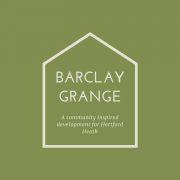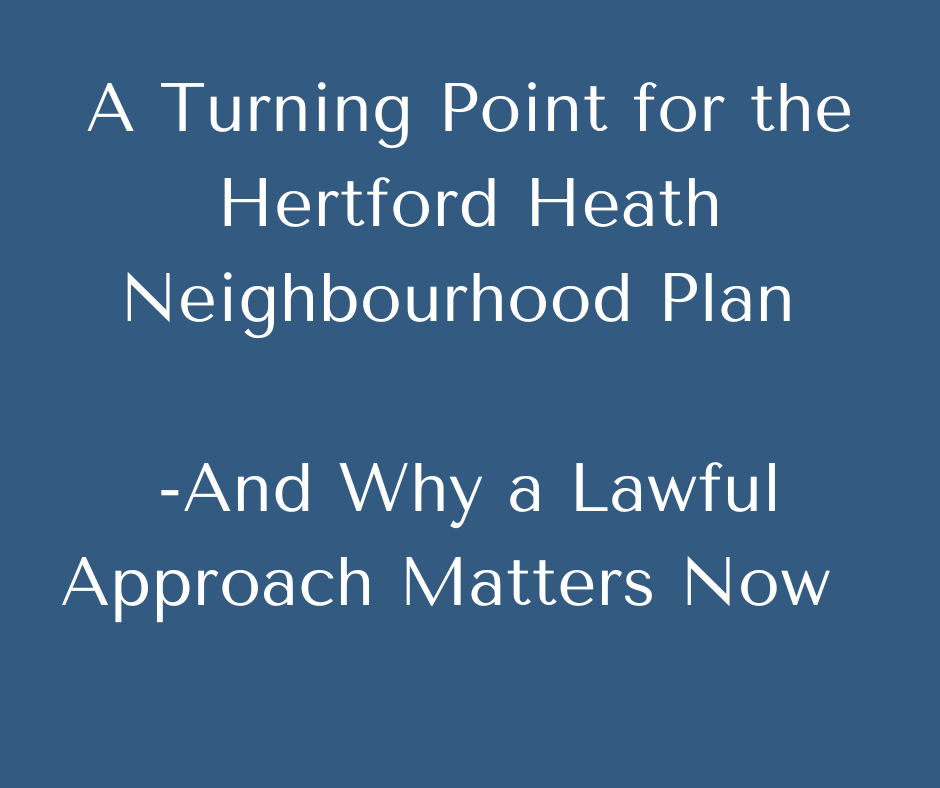As many residents may know, the Hertford Heath Neighbourhood Plan is reaching a critical stage. Local residents voted in favour of continuing the Plan process in August 2024, and the Parish Council stated its intention to complete the Plan by the end of 2025.
But while much has been said about potential development sites, recent developments have brought much-needed clarity — and an important shift in direction. This is a crucial moment for the village, as the Parish Council must ensure the Neighbourhood Plan delivers the right homes in the right places, in line with legal requirements and community aspirations.
🏛️Haileybury Site now accepted as constrained and unable to meet the Housing Target for Hertford Heath?
In the past, the Hertford Heath Neighbourhood Plan suggested that the Haileybury site alone could meet the community’s full housing needs of a minimum of 84 homes — representing the 10% growth required under the East Herts District Plan. However, the Parish Council has now formally acknowledged that earlier assumptions about Haileybury were flawed. It is now accepted that this land has serious constraints that were not properly considered and were withheld from public consultations, including:
- Significant impacts on a listed wall and railing and Three Grade II listed heritage buildings and their settings
- Ecologically sensitive zones identified by the Hertfordshire Environmental Records Centre (HERC), requiring protection and enhancement
- An inability to provide safe access from London Road without affecting listed buildings and their settings, and the removal of trees that define the village’s visual character
- A failure to comply with strategic policies DPS2, DPS3, and VILL1 of the East Herts District Plan
Crucially, these constraints mean Haileybury cannot meet the required number of homes without causing significant and unacceptable harm. This directly contradicts earlier statements and necessitates a full re-evaluation of its suitability.
Under national planning law — specifically the Environmental Assessment of Plans and Programmes Regulations 2004 and confirmed by case law — a Neighbourhood Plan must prefer sites that avoid such harm. If a suitable, less harmful site exists, it must be selected. This is not a matter of planning judgement; it is a statutory legal requirement.
If the Parish Council were to proceed with a significantly constrained site, or to introduce additional problematic land solely to support an unviable option, it would risk undermining the legal foundation of the Plan and exposing it to challenge at Examination or in the courts.
🔄 Where Do Things Stand Now? The Path to a Lawful Plan
East Herts Council has confirmed the following:
- The Parish Council must now instruct AECOM to update the Site Options and Assessment Report, ensuring that all sites are visited and assessed on the ground, and that site selection is based on accurate, objective information — not subjective preferences or assumptions made by the Neighbourhood Plan Steering Group.
- A full Strategic Environmental Assessment (SEA) must be undertaken, considering all reasonable alternatives and all relevant environmental factors to ensure the most sustainable site is lawfully selected.
This updated process must be grounded in verifiable, real-world evidence — including full site access and a clear understanding of local conditions — rather than relying solely on desk-based assumptions, which was a key flaw in the previous process.
🛤 Why Site Selection Must Be Objective and Lawful
The Neighbourhood Plan must select sites that are demonstrably sustainable — not merely those that are perceived as locally preferred or championed by individuals on the Steering Group. To comply with national policy and legal obligations, site selection must be based on independent, objective assessments such as those provided by AECOM and the Strategic Environmental Assessment (SEA).
Choosing a constrained or harmful site — such as one affected by heritage or ecological conflicts — over a suitable alternative like Barclay Grange, would be a direct breach of Policy DPS2 in the East Herts District Plan. It would also risk non-compliance with:
- The Environmental Assessment of Plans and Programmes Regulations 2004, and
- The Basic Conditions test at Examination — particularly Condition (e), which requires general conformity with the strategic policies of the development plan.
Such a failure could result in the Neighbourhood Plan being found unsound or unlawful, delaying or derailing its progress and exposing the Parish Council to legal challenge.
🌳 Why Barclay Grange Still Stands Out – Delivering on the Village’s Needs and Aspirations
When it comes to meeting the community’s housing needs and delivering on the aspirations of Hertford Heath residents, Barclay Grange stands alone. It remains the only site that:
✅ Was rated Green (most suitable) in AECOM’s independent site assessments – a clear indication of its deliverability and suitability
✅ Can meet the full housing allocation without impacting heritage assets or ecologically sensitive areas
✅ Avoids environmental or heritage harm, and has no constraints and thus directly aligns with the legal requirement to select the least harmful reasonable alternative
✅ Offers legally secured community benefits through binding Section 106 agreements and a comprehensive Masterplan — including affordable housing, a new public play space, infrastructure improvements and other community aspirations.
✅ Was the only site accompanied by a Masterplan and secured community benefits from the outset, unlike the Haileybury proposal, which offered no legally guaranteed benefits in its original form
This stark contrast demonstrates the difference between a proactive, deliverable site and one reliant on assumptions and unguaranteed outcomes.
🛠️ What Happens Next? Ensuring Transparency and Compliance
The following steps are now essential to deliver a lawful and trusted Neighbourhood Plan:
- AECOM must be re-engaged to update the Site Options and Assessment Report with full site access and proper on-the-ground analysis.
- A new Strategic Environmental Assessment (SEA) must be carried out, assessing all reasonable alternatives with up-to-date evidence and taking full account of environmental and heritage factors.
- Residents must be consulted again — but only once the evidence base is complete and lawfully prepared, so that public input is genuinely informed this time.
These steps are not only required by law — they represent the fairest and fastest route to delivering the homes the community needs without undermining heritage or the environment.
💬 Let’s Keep the Plan on Track – For Hertford Heath’s Future
Barclay Grange is not just a housing site — it is a unique opportunity to deliver real, lasting benefits for Hertford Heath through a Neighbourhood Plan that meets legal, environmental, and community expectations. It offers a clear, deliverable path forward without the risks and constraints associated with other sites.
We remain committed to transparency, legal integrity, and community engagement — and we will continue to keep residents fully informed as the process moves forward to ensure that the Neighbourhood Plan reflects the needs, values, and aspirations of Hertford Heath.
Thank you for your continued support.



